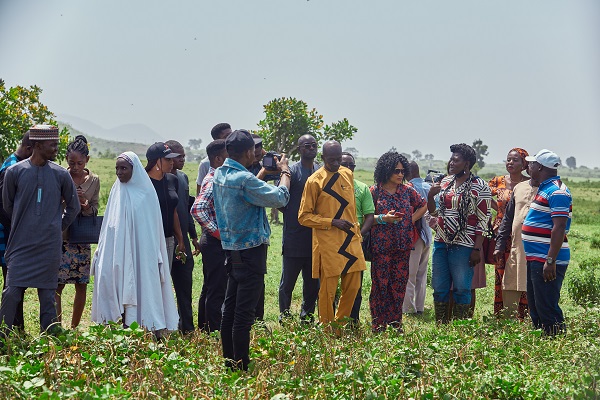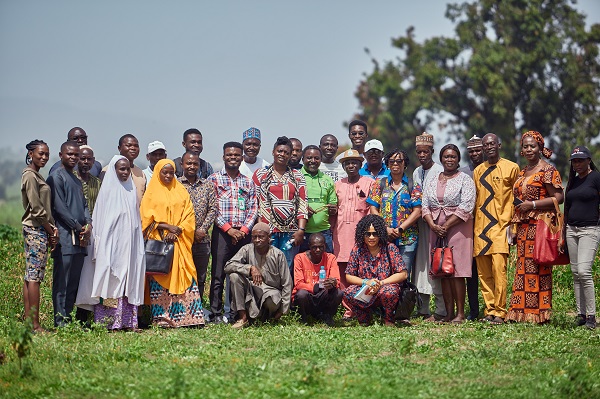
“We have already done our first harvest which was very good because the yield was very high. We counted just now and we found that one plant had over 45 pods and still counting. Once we harvested, we noticed more flowers came and that means more yields.
“At the end of the day the farmers might get tired of taking out the cowpea and leave some of it for animal residue, but as long as the person is resilient, they can bring it all out and it will translate to yield and money,” the chief executive officer, Replenish Farms Limited, Patience Koku, told a cross-section of farmers and journalists during a practical, seeing is believing tour to her farm in Abuja.
The farmer explained that this was not the case for farmers before the introduction of the Pod-Borer Resistant (PBR) Cowpea also called ‘SAMPEA 20T’, a variety resistant to Maruca Vitrata, a pod-sucking worm which can wreak havoc on a cowpea farm.
“As farmers, one of the biggest problems we have with cowpea production is a worm called Maruca. The Maruca worm is so destructive that, sometimes, we cannot harvest anything at all. It will take all the pods and suck everything out and we’ll have zero harvests.”
Koku explained that this challenge has resulted in an astronomical increase in the price of beans, referred to as “the poor man’s meat” because of its ability to provide the much-needed proteins for good health, at a very affordable rate for the poor.
“Over the years, our beans or cowpea has continued to be more expensive because farmers harvest less. So, what this variety of cowpea does for us is that it has enabled us to overcome this challenge. When we plant this cowpea, we spray less. Usually, farmers have to spray up to 10 times to get a good yield. What has happened is that we spray less two to three sprays and you can get a good harvest.
“On the whole, in the next couple of years, we expect the general price of our beans in the market to drop. Right now [a measure of] beans is almost N1,100 which is not sustainable because it is the poor man’s meat and if we cannot use beans effectively, it means that the price will continue to go up. So, we are very happy that not only will farmers make money from this but everybody will benefit because an increased production of cowpea means that we can have better, competitive prices in the market and, ultimately, this will increase the yields of cowpea in the country and also help our food security,” she added.
Listing other benefits of the improved cowpea, Koku said farmers also sell the cowpea pod, popularly called ‘kowa’ in Hausa, as animal feed which is very beneficial for cows and goats.
“Also, we sell the leaves. For this variety, the pods dry out and the leaves are still green – signifying that it is ready for harvesting. This way farmers can make money from not only the seed but also the residue which they can sell to make a lot of money,” she stated.
The farmer recommended PBR Cowpea, SAMPEA 20T, to all farmers who grow beans, due to its nutritional and commercial viability.
“Before now, I had never grown cowpea commercially but, now, I can put money in it because we can see that it is a variety that can bring back your money and more. That is very important for farmers,” Koku added.

Another farmer, Judith Ude Ekele, who corroborated Koku’s claims, thanked the Federal Government for introducing the improved beans.
Ekele opined that the PBR cowpea is of good quality because she planted it and the yield was okay. “I kept harvesting until I got tired,” she said.
The farmer added that she cooked the beans to test its edibleness. “For the cooking I used charcoal. It took just 30 to 40 minutes. It was evenly cooked (not mashed) and, given that I have an ulcer, it did not result in heartburn, as it does with the normal beans.
“I also made the local ‘akara’ and it doesn’t soak oil. It came out crispy. That was a great result. Besides its super aroma, it tastes and looks the same [as conventional beans],” she stated.
Ekele encouraged other farmers to give the PBR Cowpea a trial because the yield is much compared to the other ones and it needs less spraying – just twice – unlike the conventional variety which needs seven or more sprays.
Speaking on behalf of farmers, the vice president, All Farmers Association of Nigeria (AFAN), Chief Daniel Okafor said the association has got nothing but good reports from farmers who planted the improved cowpea.
Represented by his special assistant, Chris Onwuka, Okafor posited that the PBR Cowpea is a seed that, if planted and meticulously attended to, with the best agronomic practices gives a great yield which is more than double yields to its conventional counterpart.
“It is still a seed that you don’t use pesticide that much because the seed itself is self-resistant and, to our ecology and the farmer himself and his wards who come into the farm day to day, there is no [chance of] infection taking on any source of organic pollutant. These things stay in the environment for so long and they kill us. It is not hazardous because you don’t use many pesticides that become hazardous to your health, [that of] a pregnant woman or children.
“You discover that, after coming from their farms, some farmers get dizzy because they have used heavy pesticide for some seeds but with PBR Cowpea, there is nothing like that. This is an added advantage and, of course, you get bumper harvest,” he added.
The AFAN boss recommended that farmers go for the improved seed because there are no health disadvantages which is what farmers need.
“We are tired of having low harvests, capturing diseases from the use of chemicals and pesticides. At times, these things happen to us ignorantly which is so bad.”
Earlier in his remarks, the convener of Science Hangout Opuah Abeikwen said the field tour was to let farmers and journalists have first-hand knowledge of the benefits of the improved variety to farmers.
“We brought farmers and media people like you to see first-hand how science can help to solve our problems. We have been talking about GMOs for some time now and many people don’t know what it looks like. Today, we brought farmers to this field where GM Cowpea is cultivated so they can see and compare this to the varieties they have planted and see how science can help us solve some of our issues.
“If you can see the fields, you will see that there are no physical differences between this product and the conventional varieties. The only difference is that these are yielding better just like the farmers explained. They have harvested the first time and they have sprouted again and they harvest again on the same piece,” he said.
Abeikwen, a fellow of the Alliance for Science (who also sponsored the field trip), harped on the safety of the improved crop, adding that there is an overwhelming consensus about the safety of GMOs from very reputable organisations.


